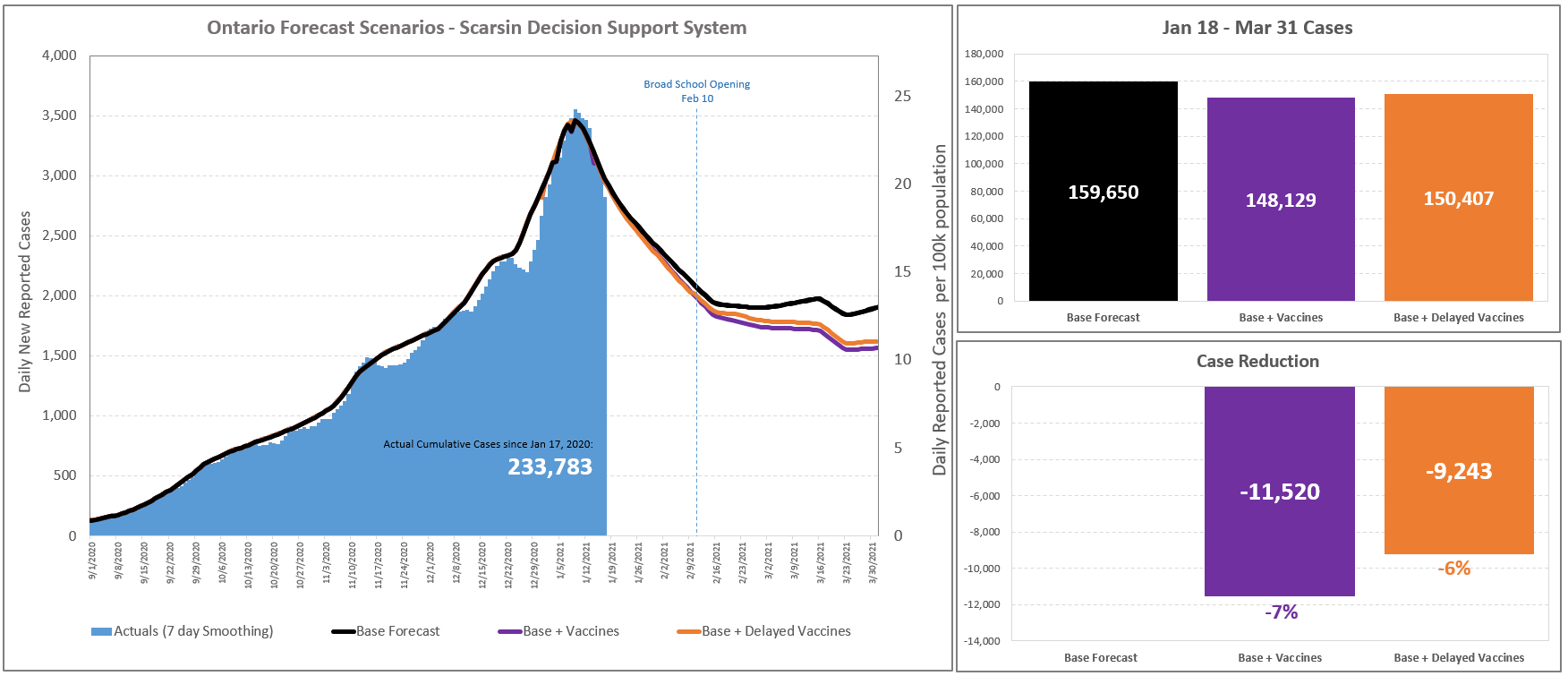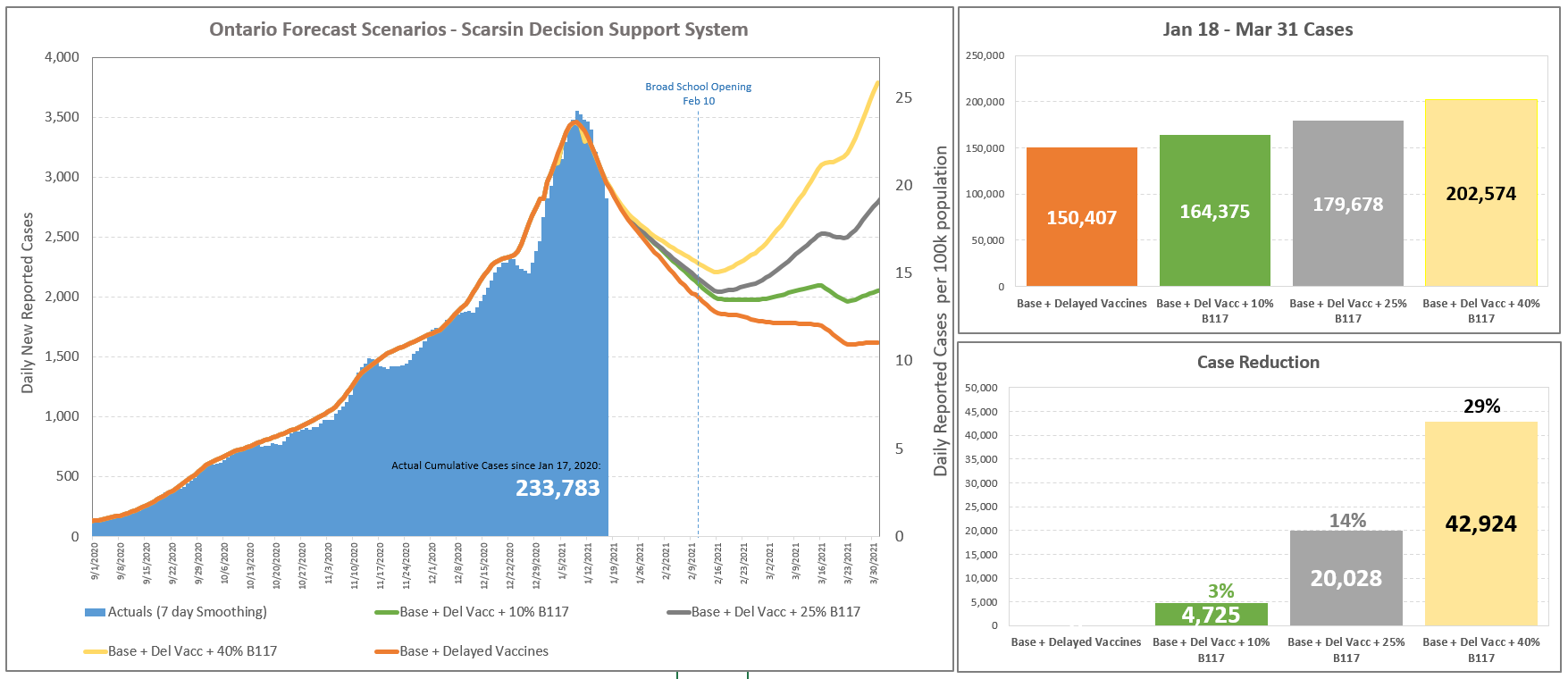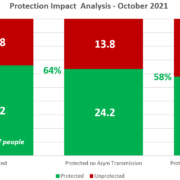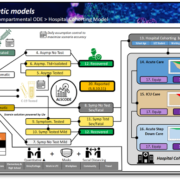The Amazing Race: Variants vs. Vaccines
By Paul Minshull, CEO & Founder, Covid19 Solution Architect
It is an understatement that Ontario’s COVID world is growing more complex by the day. There are now three important dynamics converging on the province.
- The impact of lockdowns
- The initial deployment of vaccines
- New, more transmissible variants gaining hold
In this forecast, based on January 18 data, our focus is on these new variants and their impact on decision making to the end of March – precisely the challenges the Scarsin platform is designed to address.
Key Findings
- Lockdown is working! Ontario cases are decreasing
- School opening presents a risk to achieving lockdown goals and decelerating variant spread
- Pfizer vaccine delays so far are minimal in terms of reducing transmission benefit
- Vaccines will reduce transmission, but likely not as fast as we hope
- New, more transmissible variants are the biggest threat to progress against COVID-19
We approached the analysis in two phases. The first phase focused on isolating the benefits of the lockdown interventions and vaccine program. Let’s start with the lockdown impact. Dr Williamson recently outlined the provincial goal to see cases below 1,000 per day prior to lifting the lockdown.[i] We are applying our assumptions toward achieving that goal, given one key assumption — the opening of schools on Feb 10, in alignment to current provincial announced policy, although some regions are opening earlier.[ii]
Given the projections shown in the black forecast (below), other elements of the lockdown will remain in effect for this planning period. Opening the schools has a material impact on transmission with kids returning to classrooms, teachers and staff returning to the workplace, and parents heading to work when childcare at home is no longer required. We recognize that opening the schools is a complicated decision with other considerations; however, viewed through the lens of transmission, it is a risky move, given the positivity rate in children remains high (>10%).

We have assumed that variants reach 4% of the positive cases by March 31. This contributes to the change in slope of the base forecast. We created two alternative forecasts that take into consideration the vaccine rollout in Ontario.
The purple forecast (above) relates to the original planned deployment of the Moderna and Pfizer vaccines with approximately 6-million Canadian doses [i] to the end of March, with about 2.2-million in Ontario. The orange forecast reflects the impact of the delay announced on Jan 21, which sees only about 100,000 doses in February.
Although there is potential for this situation to change as the schedule for Pfizer/BioNtech is being updated, [ii] it is important to note that the Scarsin model adjusts for the timing of probable based immunity. We have used 65% immunity one week after the initial dose for the between doses level (which is slightly higher than current references of 52% [iii] [iv], including Pfizer [v]) and then 95% immunity one week after the final dose. As a result, there is a timing effect to the vaccine benefit, especially when the vaccinations are ramping up January to March.
Bottom line: the delayed vaccine schedule would reduce transmission by about 6%. It will, however, have a stronger impact on hospitalizations and deaths, given the focus on long term care and retirement homes. The Ontario Science Table released a report on this on January 21.[vi]
Unfortunately, the addition of vaccine protection to March 31 does not appear to direct the transmission to the stated goal of 1,000 cases per day based on opening schools.
New variants are game-changers
The second phase of the decision analysis focused on the potential penetration of new variants (UK, Brazil, South Africa, Ohio). We assumed a general profile with 55% more transmission than the original form and evaluated potential penetration at three levels (see below): 10% (green), 25% (grey) and 40% (yellow) of the positive tests by the end of March. The forecasts below illustrate the potentially game-changing effect that increased transmission from variants can have on the Ontario dynamics.

There is a lot of uncertainty about how fast these variants will spread in Ontario. These represent generally more conservative assumptions than the behaviour in the UK for B117 and the simulation presented by the Ontario Science Table (slide 17)[i].
We evaluated these based on two key differences. First, Ontario is in lockdown now, while the UK was not during its B117 acceleration period. The second difference deals with the density and spread of population in Ontario. Closer monitoring of current levels and trends over time could much better inform these discussions, but It is relevant to note that the UK peaked at >80 cases per 100k per day, compared to Ontario’s recent peak of 25 per 100,000. This is obviously a profound difference. The UK is making progress in decreasing spread using conventional lockdown measures, but these must be strongly adhered to, and they still have a long way to go as they were around 70 cases per 100,000 on January 17. The big question is how fast will it rise when they begin to ease controls in alignment to their vaccine rollout?
There are very tough decisions ahead in relation to non-pharmaceutical interventions (schools, lockdowns, etc.), at the same time as vaccines are deployed and potential variants spread. At Scarsin, we built our decision system for this exact level of complex decision making.
The system is proving extremely agile in running scenarios to inform decision makers. Our goal remains to support Ontario in its decision making processes.
[1] https://www.cbc.ca/news/politics/what-you-need-to-know-about-vaccine-rollout-1.5882033
[1] https://www.bmj.com/content/371/bmj.m4826
[1] https://www.nytimes.com/2020/12/08/health/covid-vaccine-pfizer.html
![scarsin logo black] Scarsin COVID 19](https://scarsin-covid.com/wp-content/uploads/2020/03/scarsin-logo-black.png)

